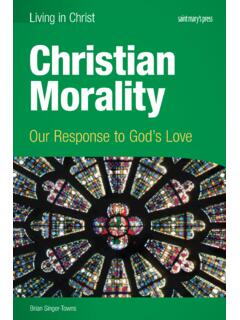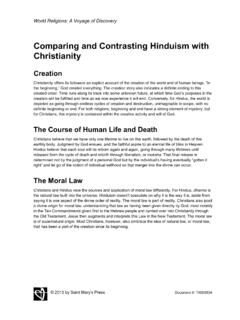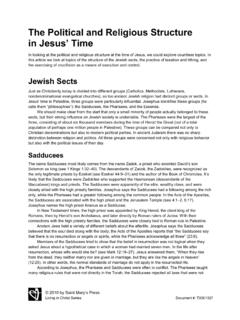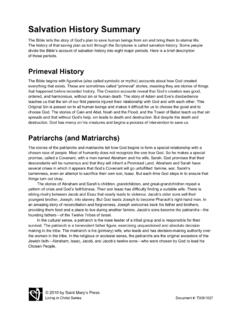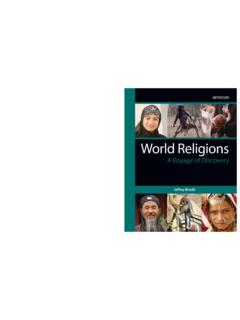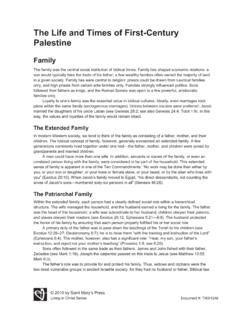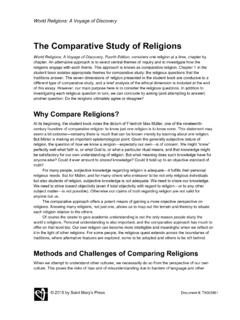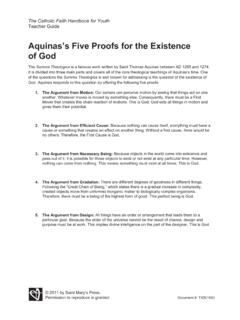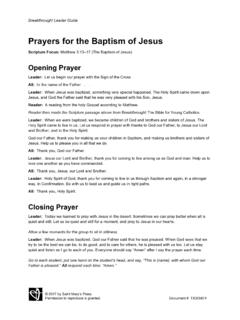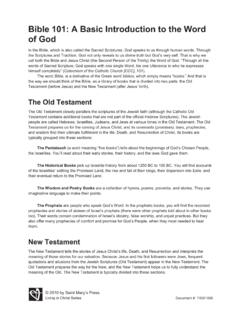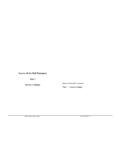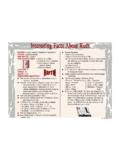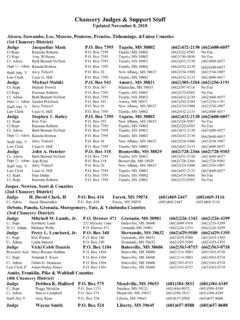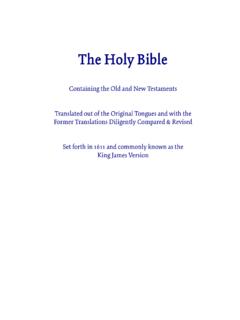Transcription of The JEPD Theory
1 2010 by Saint Mary s Press Living in Christ Series Document #: TX001002 The JEPD Theory A long tradition holds that the five books of the Pentateuch or Torah (Genesis, Exodus, Leviticus, Numbers, and Deuteronomy) were written by Moses. The tradition honors Moses because of his esteemed position as lawgiver and friend of God. But it is highly unlikely that he wrote the version of the Pentateuch that we have today. Even a casual reader will notice problems with this idea when reading the text. There are inconsistencies and duplications, not to mention the fact that Moses would have needed to write about his own death before it happened.
2 Scholars in the last century have felt that the best way to explain the various inconsistencies and duplications in the books of the Pentateuch is to assume that the books are a redaction that is, an edited version of several different original sources. This is called the documentary hypothesis. Using the techniques of source criticism and redaction criticism, some modern scholars propose that four sources (or traditions) contributed to the five books of the Pentateuch. These sources are the following: the Yahwist (abbreviated J from the German word for Yahwist) the Elohist (abbreviated E) the Deuteronomist (abbreviated D) the Priestly (abbreviated P) Based on the abbreviations used for the four sources, the documentary hypothesis is also called the four-source Theory or the JEPD Theory .
3 These four sources have been identified by biblical scholars by their specific literary styles and theological concerns. The Theory also proposes that each source reflects a particular community and historical situation, which explains the focus of their theology. We will briefly examine each source s perspective. Keep in mind that this is only a Theory ; we have no actual J, E, or P texts apart from the Bible itself. (On the other hand, the Book of Deuteronomy is widely accepted as the work of an independent author who had little if any responsibility for Genesis, Exodus, Leviticus, or Numbers. Thus, Deuteronomy is the D text.)
4 The Yahwist (J) The Yahwist source originated in the southern kingdom (Judah), perhaps as early as the reigns of King Solomon or even King David. It is the earliest source, dating back to the tenth century BC. Its theology is focused on God s promises for salvation and the importance of cultic worship. Here are some of the characteristics of the Yahwist source: God is referred to as Yahweh (translated as LORD [small caps] in English). The holy mountain is called Sinai. God is anthropomorphized that is, he is given human characteristics and feelings. (He walks in the garden and talks with Adam.) The natives of Palestine are called Canaanites.
5 Some examples are the story of Adam and Eve (see Genesis 2:4 25) and the account of the Ten Plagues (see Exodus 7:14 10:29). The Elohist (E) The Elohist source developed in the northern kingdom (Israel). It is thought to have developed a little later than the J source, in the ninth century BC. Its theology focuses less on Temple worship (that happened in The JEPD Theory Page | 2 2010 by Saint Mary s Press Living in Christ Series Document #: TX001002 the southern kingdom) and more on morality and Israel s proper response to God: faith and fear of the Lord. Some think that the Elohist tradition reworked the Yahwist writing, altering the perspective from J s pro-monarchy perspective to a more pro-covenant perspective.
6 Some of the characteristics of the Elohist source are these: It emphasizes prophecy. God is referred to as Elohim ( Lord God in English translation). The holy mountain is Horeb. The natives of Palestine are called Amorites. God speaks in dreams. Some examples are the sacrifice of Isaac (see Genesis, chapter 22) and the Ten Commandments (see Exodus 20:1 17). The Deuteronomist (D) The Deuteronomist source is the clearest independent source. The author is responsible for most if not all of the Book of Deuteronomy and most likely the historical books of Joshua through Second Kings (not including ruth ).
7 This collection of books, Deuteronomy through Second Kings, is called the Deuteronomistic history and was most likely written in the seventh and sixth centuries BC. But the person(s) responsible for creating this collection remains a mystery (although the Book of Deuteronomy is often associated with the book found by King Josiah around 622 BC [see 2 Kings, chapter 22]). The Deuteronomist theology teaches that all the bad things that happened to the Israelites were God s punishment for the grave sins of the leaders and the people. Some characteristics of the Deuteronomistic source are these: The book of Deuteronomy is a retelling of the stories of Exodus through Numbers (Deuteronomy means second law ).
8 Deuteronomy interprets Israel s history as a cycle of God s forgiveness and renewal of the Covenant, followed by the people s failure to live the Covenant, followed by the bad things that happen to them as punishment. It emphasizes the Israelites covenantal obligation. The holy mountain is Horeb. It emphasizes law and morals. An example is the Book of Deuteronomy. The Priestly (P) The priestly source is thought to have developed during and after the Exile (587 538 BC), thus it dates around the sixth century BC. Some think it never existed as an independent source but is the work of the final person or group revising and adding to the JED sources after they had been joined (see below).
9 The theology of this source is that the Jewish people s religious identity is found in proper worship and special laws that set them apart from other people. It represents the priestly class s rejecting the idea of religious identity being found in a divinely appointed king (an approach which had failed them). Rather, this source focused on cult and ritual. The priestly source has these characteristics: The JEPD Theory Page | 3 2010 by Saint Mary s Press Living in Christ Series Document #: TX001002 emphasis on Temple cult and worship emphasis on the southern kingdom of Judah (because that is the location of Jerusalem and the Temple where cultic worship occurs) emphasis on the role of the Levites, the priestly class or tribe emphasis on genealogies and tribal lists, which established the different groups in Israelite society, including the priestly class emphasis on order and the majesty of God and creation examples.
10 First Creation story (see Genesis 1:1 2:4), the Book of Leviticus Summary Chart of Four Pentateuch Sources Date Place Divine Name Religious features Literary features Yahwist United Monarchy (~950 BC) Jerusalem? Uses Yahweh throughout the Pentateuch Sacrifice is not limited to one single place nor is the priesthood limited to one family. Heads of household can make sacrifices. Lively narrative and anthro- pomorphic view of God. Elohist Divided Monarchy (~850 BC) Northern Kingdom (Israel) Elohim used exclusively until the divine name is introduced in Exodus. Sacrifice is not limited to one single place nor is the priesthood limited to one family.
